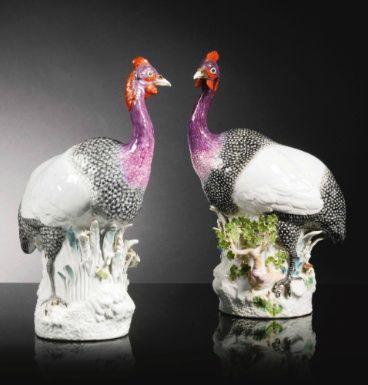Two important and rare Meissen figures of Guinea fowl, 1735
Two important and rare Meissen figures of Guinea fowl, 1735 - Sotheby's
modelled by J. J. Kändler for the Japanese Palace, Dresden, each bird standing on a rocky mound base amongst various grasses and flowering leafy branches, with white-speckled black plumage, long purple necks curving to the left and red combs and wattles (minor restoration and chips); 43.5cm., 17 1/8 in. high. Estimation: 150,000 - 200,000 GBP
PROVENANCE: The Royal Collections of Saxony, Japanese Palace, Dresden
The Ole Olsen Collection, Copenhagen
Ole Olsens Collection, Part I, Winkel and Magnussen, Copenhagen, January 1944, lot 295
Curt Berndorf, Copenhagen
Angela Gräfin von Wallwitz, Munich
EXHIBITED: London, Asprey, no. 3A and B
NOTE: As recorded by Wittwer (2006), p. 339, of the twenty-eight figures of guinea fowl ordered between 1732 and 1736, only seven were completed and delivered to the Japanese Palace in 1735. Kändler's work report of March 1735 records his working on the model: 'Eine Berel Henne ebenfalls ins Ballåis gehörig Nach ihrer sonderbaren Arth Vorgebildetan Welcher aber noch etwas Weniges zu thun.' [one guinea fowl also for the Palace, duly representing its strange characteristics, to which there is a little something more to do]; and the following month he reports that the model is completed, 'Die Berel Henne folgends fertig gemacht' [The guinea fowl has been made ready]. During June and July of the same year there are two deliveries to the Palace, of one and six enamelled figures, respectively.
In 1769, the Tower Room inventory lists two guinea fowl in the Royal Residence but the inventories of 1770 and 1779 each mention only bird, presumably same one that is recorded in the Royal Collection in 1900 and which remained there at least up to 1935, when it is illustrated by Albiker (1935), pl. XXII, figs. 68 and 69. In addition to the present examples, there were two other birds of this model in the collection of Walter von Pannwitz, one of which is illustrated by Brüning (1904), Color Plate XIII, no. 409. Both were subsequently sold at Galerie Helbing, Munich, October 24 and 25, 1905, lots 401 and 402, as part of the larger sale of the von Pannwitz collection, and are illustrated in at least two contemporary publications reporting on the auction: R. Freih. von Seydlitz, 'Die Sammlung V. Pannwitz (München)', Kunst und Kunsthandwerk, 1905, Vol. VIII, pp. 302-03, and Karl Voll, 'Die Sammlung v. Pannwitz in München', Kunst und Künstler, 1906, Vol. IV, p. 31. The upcoming sale was also reported in 'The von Pannwitz Collection at Munich', The Athenæum Journal of Literature, Science, the Fine Arts and the Drama, October 14, 1905, no. 4068, p. 510, where, interestingly, the article cites two other similar examples, one in the "Palace at Dresden" and another in the " Johanneum at Dresden" (where the Japanese Palace collection was moved in 1876). The same publication reports the sale results on page 618 of its November 4, 1905, no. 4071, issue: "The Pannwitz collection, dispersed at Munich on October 24th and 25th, realized a total of 1,150,000 marks, very high prices being paid for rare examples of Meissen china. A pair of life-sized guinea fowl fetched 38,000m....", an extraordinary price paid for the time. The whereabouts of the von Pannwitz birds and the other three guinea fowl made for the Japanese Palace remainunknown.
Sotheby's. Property from the Collection of Sir Gawaine and Lady Baillie. London | 01 mai 2013 - www.sothebys.com

/https%3A%2F%2Fprofilepics.canalblog.com%2Fprofilepics%2F1%2F0%2F100183.jpg)
/https%3A%2F%2Fstorage.canalblog.com%2F03%2F02%2F119589%2F96711876_o.jpg)
/https%3A%2F%2Fstorage.canalblog.com%2F11%2F31%2F119589%2F94773502_o.jpg)
/https%3A%2F%2Fstorage.canalblog.com%2F20%2F83%2F119589%2F94772815_o.jpg)
/https%3A%2F%2Fstorage.canalblog.com%2F26%2F72%2F119589%2F75604929_o.jpg)
/https%3A%2F%2Fstorage.canalblog.com%2F59%2F60%2F119589%2F26458628_o.jpg)




/http%3A%2F%2Fstorage.canalblog.com%2F78%2F88%2F119589%2F126226333_o.jpg)
/http%3A%2F%2Fstorage.canalblog.com%2F69%2F72%2F119589%2F122404760_o.jpg)
/http%3A%2F%2Fstorage.canalblog.com%2F85%2F15%2F119589%2F122404663_o.jpg)
/http%3A%2F%2Fstorage.canalblog.com%2F55%2F26%2F119589%2F122404554_o.jpg)